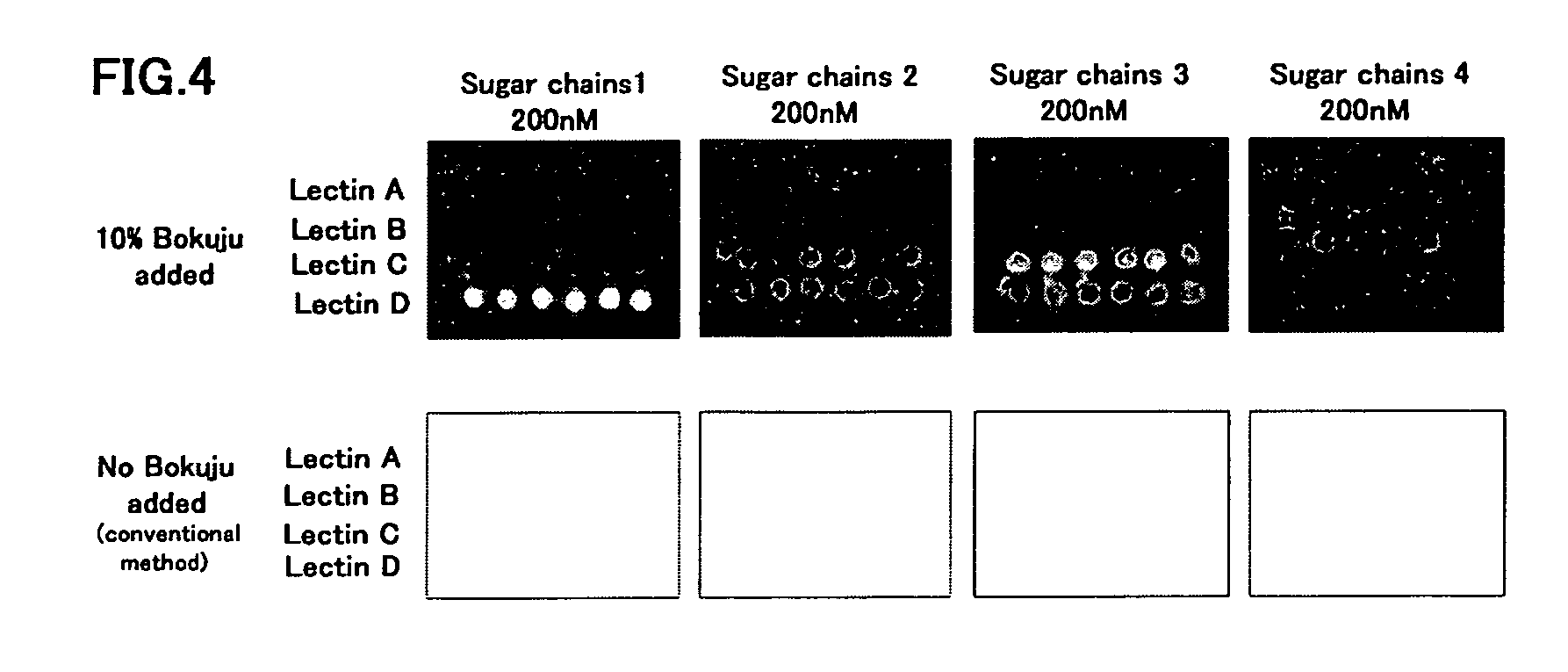Evanescent wave excited fluorescence detection method
a fluorescence detection and excited technology, applied in the field of evanescent wave excited fluorescence detection method, to achieve the effect of reducing background noise, enhancing s/n ratio, and further enhancing s/n ratio
- Summary
- Abstract
- Description
- Claims
- Application Information
AI Technical Summary
Benefits of technology
Problems solved by technology
Method used
Image
Examples
example 1
[0029] As experiments for analyzing sugar chain structure, a microarray having many lectins as interactional substances immobilized on a slide glass used as the light transmitting plate 1 was prepared, and the fluorescence levels in the interactions between a fluorescently labeled glycoprotein and the lectins were detected in a liquid layer using the above-mentioned analyzing apparatus.
experimental results 1
[0030] At first, 10 vol % of Bokuju was added to a interaction solution containing the fluorescently labeled glycoprotein, and the mixture was supplied onto a slide glass to carry out interactions. In this case, the luminance value of the background where no lectin existed on the slide glass, i.e., the background noise was measured. Furthermore, the luminance value of the portion reflecting the amount of each lectin and the glycoprotein bound to each other was also measured. In this experiment, Bokuju had been added when the interactions between the interactional substances and the fluorescently labeled test substance started.
[0031] As described above, in any conventional method, it is necessary to carry out gel filtration purification for the purpose of removing an excessive amount of the fluorescence dye used for labeling the test substance before the interactions between the fluorescently labeled test substance 13 and the interactional substances 12 are performed. So, in this ex...
experimental results 2
[0043] Unlike the experiment shown in Tables 1 and 2, in this experiment, Bokuju was not added before start of the interactions between the interactional substances and the fluorescently labeled test substance. Instead 1 to 50 vol %, particularly 1 vol %, 10 vol % or 50 vol % of Bokuju was added to the liquid layer after interactions and immediately before measurement. In this case, the luminance value of the background where no lectin existed on the slide glass, i.e., background noise was measured, and the luminance value of the portion reflecting the amount of each lectin and the glycoprotein bound to each other was also measured. In this experiment, the gel filtration purification step was carried out. The results are shown in Table 3.
TABLE 3After standing for 24Immediately afterImmediately afterImmediately afterhours subsequently toBefore additionadding 1% Bokujuadding 10% Bokujuadding 50% Bokujuaddition of 50% bokujuS / NS / NS / NS / NS / NNet intensity*ratioNet intensity*ratioNet int...
PUM
| Property | Measurement | Unit |
|---|---|---|
| evanescent wave excited fluorescence detection | aaaaa | aaaaa |
| fluorescence | aaaaa | aaaaa |
| fluorescent | aaaaa | aaaaa |
Abstract
Description
Claims
Application Information
 Login to View More
Login to View More - Generate Ideas
- Intellectual Property
- Life Sciences
- Materials
- Tech Scout
- Unparalleled Data Quality
- Higher Quality Content
- 60% Fewer Hallucinations
Browse by: Latest US Patents, China's latest patents, Technical Efficacy Thesaurus, Application Domain, Technology Topic, Popular Technical Reports.
© 2025 PatSnap. All rights reserved.Legal|Privacy policy|Modern Slavery Act Transparency Statement|Sitemap|About US| Contact US: help@patsnap.com



